RC - What is RC? - Rotterdam Convention
RC - What is RC? - Rotterdam Convention
RC - What is RC? - Rotterdam Convention
You also want an ePaper? Increase the reach of your titles
YUMPU automatically turns print PDFs into web optimized ePapers that Google loves.
admin<strong>is</strong>tration to experimental animals, but the rate of absorption<br />
following inhalation or dermal exposure has not been investigated.<br />
In rats and mice, the compound d<strong>is</strong>tributes mainly to the liver,<br />
kidneys and adipose t<strong>is</strong>sue. It <strong>is</strong> rapidly excreted. Binding to<br />
liver<br />
and kidney protein and nucleic acids has been demonstrated.<br />
a<br />
The biotransformation of the compound in experimental animals<br />
appears to be a saturable process. Th<strong>is</strong> process proceeds mainly<br />
through a glutathione-mediated pathway in which hexachlorobutadiene<br />
<strong>is</strong> initially converted to S-glutathione conjugates. These<br />
conjugates can be metabolized further, especially in the<br />
brush-border membrane of renal tubular cells, to a reactive sulfur<br />
metabolite, which probably accounts for the observed nephrotoxicity,<br />
genotoxicity and carcinogenicity.<br />
1.6 Effects on organ<strong>is</strong>ms in the environment<br />
Hexachlorobutadiene <strong>is</strong> moderately to very toxic to aquatic<br />
organ<strong>is</strong>ms. F<strong>is</strong>h species and crustaceans were found to be the most<br />
sensitive, 96-h LC50 values ranging from 0.032 to 1.2 and 0.09 to<br />
approximately 1.7 mg/litre for crustaceans and f<strong>is</strong>h, respectively.<br />
The kidney was demonstrated to be an important target organ in f<strong>is</strong>h.<br />
Based on several long-term tests with algae and f<strong>is</strong>h species,<br />
no-observed-effect level (NOEL) of 0.003 mg/litre was establ<strong>is</strong>hed;<br />
th<strong>is</strong> classifies the compound as very toxic to aquatic species.<br />
End-points investigated include general toxicity, neurotoxicity,<br />
biochem<strong>is</strong>try, haematology, pathology, and reproductive parameters.<br />
In one 28-day early-lifestage test with fathead minnows,<br />
reproduction was unaffected at concentrations of up to<br />
0.017 mg/litre, whereas increased mortality and a decreased body<br />
weight were observed at 0.013 and 0.017 mg/litre. The NOEL was<br />
0.0065 mg/litre.<br />
Only one reliable test with terrestrial organ<strong>is</strong>ms has been<br />
described. In a 90-day test with Japanese quail, receiving a diet<br />
containing the compound at concentrations from 0.3 to 30 mg/kg diet,<br />
the survival of chicks was decreased at 10 mg/kg diet only.<br />
1.7 Effects on experimental animals and in vitro test systems<br />
1.7.1 General toxicity<br />
Hexachlorobutadiene <strong>is</strong> slightly to moderately toxic to adult<br />
rats, moderately toxic to male weanling rats, and highly toxic to<br />
female weanling rats following a single oral dose. The major target<br />
organs are the kidney and, to a much lesser extent, the liver.<br />
Based on animal data, the vapour of hexachlorobutadiene <strong>is</strong><br />
irritating to mucous membranes and the liquid <strong>is</strong> corrosive. The<br />
substance should be regarded as a sensitizing agent.<br />
In the kidneys of rats, mice and rabbits, hexachlorobutadiene<br />
causes a dose-dependent necros<strong>is</strong> of the renal proximal tubules.








